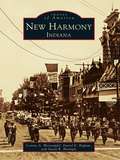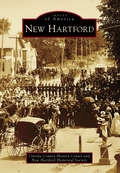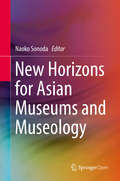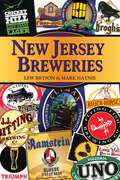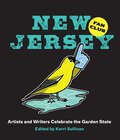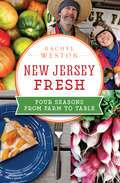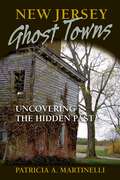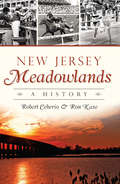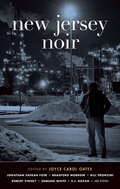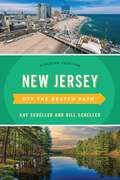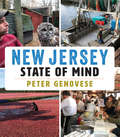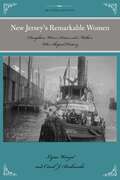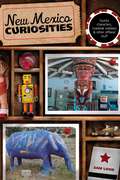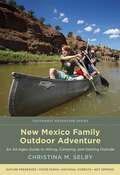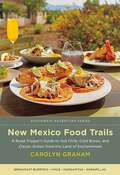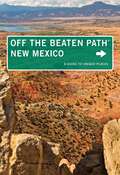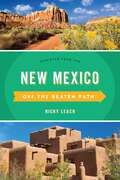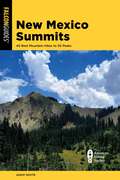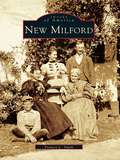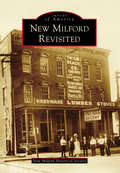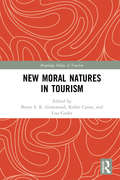- Table View
- List View
New Harmony, Indiana
by Darrel E. Bigham Susan R. Branigin Connie A. WeinzapfelNew Harmony is a town like no other. A community thatbegan almost two hundred years ahead of its time, New Harmony was a spiritual sanctuary that later became a haven for international scientists, scholars, and educators who sought equality in communal living. It was impossible for George Rappto realize the events he would set into motion when he purchased 20,000 acres of land on the Wabash River in 1814 and subsequently sold it to social reformer Robert Owen ten years later. This simplecommunity came to have an immense impact on our country's art and architecture, public education system, women's suffrage movement, Midwestern industrial development, and more. This book contains over 150 historic images produced by two 19th-century New Harmony photographers--Homer Fauntleroyand William Frederick Lichtenberger. These photographs show historic buildings of New Harmony, many of which have been razed over the years. They also demonstrate the importance of the Wabash River and its influence on settlement and commerce. The people of the community are captured at work and at play, and the reader is allowed a look at the downtown business district of the past and the farms surrounding it.
New Hartford (Images of America)
by New Hartford Historical Society Oneida County CenterAfter having gone bankrupt from a fire on his New Hampshire farm, Jedediah Sanger purchased 1,000 acres of land in Whitestown in 1788. This land, part of the Coxe Patent, came to be known as New Hartford. This new town was created when the town of Whitestown was divided in April 1827. The village of New Hartford was formed in 1870. Chadwicks, Middle Settlement, Washington Mills, and Willowvale also existed within the town. Throughout the early 19th century, industry flourished in New Hartford. The Sauquoit Creek supplied power to businesses, including tanneries, knitting mills, sawmills, and canning factories. Local farms provided adequate supplies of vegetables and meat. The installation of Seneca Turnpike boosted New Hartford’s economy as it became the main thoroughfare west from Utica. Prosperity followed, especially after Commercial Drive was developed in the 20th century. Today, New Hartford is Oneida County’s retail center.
New Haven Noir (Akashic Noir #0)
by John Crowley Stephen L. Carter Alice Mattison Sarah Pemberton Strong Michael Cunningham Amy Bloom Chris Knopf Roxana Robinson Karen E. Olson Chandra Prasad Jessica Speart Jonathan Stone Hirsh Sawhney David Rich Lisa D. GrayLisa D. Gray's story "The Queen of Secrets" won the Robert L. Fish Memorial Award!John Crowley's story "Spring Break" won the 2018 Edgar Award for Best Short Story!"In an Ivy League town, Bloom turns Yale's motto--Lux et Veritas--on its head, finding darkness and deceit in every corner of New Haven...The stories Bloom chooses share a strong sense of place, detailing the quirks that make every corner of New Haven distinctive. But it's the lucid writing and clear, compelling storylines that make her dark tales shine. Maybe she offers a noir version of Light and Truth after all."--Kirkus Reviews"Town-gown tensions highlight several of the 15 stories in this stellar Akashic noir anthology set in the Elm City...This [volume] is particularly strong on established authors, many of whom have impressive credentials outside the genre."--Publishers Weekly, Starred Review"[It's] a kick to see Elm City haunts and issues weaved into short stories of intrigue by writers who know the turf."--New Haven Register"Fifteen writers, many from Connecticut, including Bloom, have contributed stories to the book. Some stories are classic film noir-style, in which an unscrupulous woman leads a desirous man to his own destruction. Some tell stories of criminal youths meeting someone they underestimated, undermining their cocky street-smarts. Other stories tell of Yalies whose sophisticated exteriors hide a seething hunger for recognition. A few stories go full-on eerie, such as the shy catalog artist who is not the person he seems to be, and the unseen man in Room 11 of the Duncan Hotel, whose daily activities are a mystery to the hotel staff. Town vs. gown tensions pop up in several stories, as do dark narratives reflecting the city's history of racial tensions."--Hartford Courant"Fifteen of New Haven's literary lights have put ink to paper (or bytes to screen?) to summon that 'noir' city of the imagination that lurks just below the rapidly gentrifying surface."--New Haven IndependentAkashic Books continues its award-winning series of original noir anthologies, launched in 2004 with Brooklyn Noir. Each book comprises all new stories, each one set in a distinct neighborhood or location with the respective city. Amy Bloom masterfully curates a star-studded cast of contributors, including Michael Cunningham, Stephen L. Carter, and Roxana Robinson, to portray the city's underbelly.Brand-new stories by: Michael Cunningham, Roxana Robinson, Stephen L. Carter, John Crowley, Amy Bloom, Alice Mattison, Chris Knopf, Jonathan Stone, Sarah Pemberton Strong, Karen E. Olson, Jessica Speart, Chandra Prasad, David Rich, Lisa D. Gray, and Hirsh Sawhney.From the introduction by Amy Bloom:New Haven may be a noir town but, even though noir usually manages not to, we have heart. The chance to bring together some of my favorite writers, in my adopted hometown (in every place I bartended, the cook or the manager carried a .38 in his waistband, and I can still make ten kinds of boilermakers), was a joy and a privilege. Every single story is a noir gem...If you are an optimist, noir may be an antidote, a crisp, dry balance for your sunny outlook. If you are a pessimist (or, as we say, a realist), noir is your home ground, your tribe. It's not just that you expect ants to come to the picnic; you know damned well that there will be ants at the picnic. When they come, you're relieved. When they crawl up your brother's leg, you're reassured and possibly delighted. But the other side of noir is the moral center. The center may be shabby, frayed, and in serious need of a facelift, but it is a center. It's not necessarily heroic. It's likely to be cynical, and its resilience is not the showy kind. Mean streets, as Raymond Chandler once said, not but mean.That's New Haven.
New Horizons for Asian Museums and Museology
by Naoko SonodaThis book presents up-to-date information about museums and museology in present-day Asia, focusing on Japan, Mongolia, Myanmar, and Thailand. Asian countries today have developed or are developing their own museology and museums, which are not simple copies of European or North American models. This book provides readers with carefully chosen examples of museum activities for example, exhibition and sharing information, database construction, access to and conservation of museum collections, relationships between museums and local communities, and international cooperation in the field of cultural heritage. Readers are expected to include museum professionals and museology students. Throughout the course of this book, the reader will understand that a museum is not only a place for collecting, representing, and preserving cultural heritage but also plays a fundamental role in community development. This book is highly recommended to readers who seek a worldwide vision of museum studies. The peer-reviewed chapters in this volume are written versions of the lectures delivered by selected speakers at the international symposium "New Horizons for Asian Museums and Museology" held in February 2015 at the National Museum of Ethnology, Japan. "
New Jersey Breweries (Breweries Series)
by Lew Bryson Mark HaynieThis is a guidebook to 23 breweries and brewpubs across the Garden State, from corporate giants to the newest brewpubs.
New Jersey Fan Club: Artists and Writers Celebrate the Garden State
by Pooja Makhijani Caren Lissner Chris Gethard Christopher Smith Jen A. Miller Emily Thompson Linda J. Barth Michael C. Gabriele Sarah Prager Alexandra Beguez Scott Neumyer Alicia Cook Kate Morgan Whit Taylor Raakhee Mirchandani Brandon Stosuy Kerri Sullivan Matthew Taub Frankie Huang Erinn Salge Brandon Harrison Mike Dawson Wills Kinsley Kat Schneider Stacey Mei Fong Kamelia Ani Brittany Coppla Jacquinn Sinclair Carlos Dengler Miko Beach Team 1:1 Jersey Brittany Ingersoll Caiti Borruso Elise Sacco Lucy Dean Stockton Bob Varettoni Erica Commisso Hallel Yadin Kae Lani Palmisano Lisa Rosalie Eisenberg Donnie Martino Hassan Ghanny Lorraine Goodman Alex Flannery Haley Simone Jonathan Conner Joy Velasco Kasey Bohnert Julie Benbassat Sean Rynkewicz Mikhaila Leid Veronica Casson Dan Misdea Kristen Broderick Tori Wehringer Lauren H. Adams Katie Reynolds Kate Watt Tim Kauger Brian Scully Jaclyn Sovern Donovan Myers R Justin McNeill Dan SchenkerDespite the many jokes and stereotypes about New Jersey and its residents, in reality the state is a wildly diverse place, home to a vast variety of landscapes, cultures, and people. There is no singular New Jersey experience, and the stories that its residents have to share about the state will surprise you. New Jersey Fan Club: Artists and Writers Celebrate the Garden State is an eclectic anthology featuring personal essays, interviews, and comics from a broad group of established and emerging writers and artists who have something to say about New Jersey. It offers a multifaceted look at the state’s history and significance, told through narrative nonfiction, photographs, and illustrations. New Jersey Fan Club is edited by Kerri Sullivan, founder of the popular Instagram account Jersey Collective (@jerseycollective), which features weekly takeovers by different New Jerseyans. This book functions the same way: it gives dozens of different contributors the chance to share what New Jersey looks like to them. The book is an exploration of how the same locale can shape people in different ways, and it will inspire readers to look at the Garden State with fresh eyes and appreciate its bounty of beautiful places and vibrant spaces.
New Jersey Fresh: Four Seasons from Farm to Table (American Palate)
by Rachel WestonNew Jersey's bounty is ripe for the picking. The state boasts thousands of thriving farms, hundreds of CSAs, dozens of community farmers' markets and countless residents dedicated to the locavore lifestyle. Jersey food writer and chef Rachel J. Weston takes a seasonal tour of the state, showcasing the bounty that its down-to-earth farmers, creative artisan producers and innovative chefs produce for their patrons throughout the year. See how globally inspired cuisine representing New Jersey's diverse population is created and adapted using locally sourced products. Savor a juicy August peach, pucker up for a tart cranberry in October and nourish body and soul with local bok choy, asparagus and tomatoes. With local recipes for every season, this book shows why New Jersey is the Garden State.
New Jersey Ghost Towns
by Patricia A. MartinelliExplores settlements and towns that have been deserted, transformed into tourist attractions, or have less than 200 residents and are mere shadows of their former selves.
New Jersey Meadowlands: A History (Brief History)
by Ron Kase Robert CeberioSituated in northern New Jersey, the Meadowlands region is one of stark contrasts as more than thirty square miles of protected wetlands sit close to MetLife Stadium and across the Hudson from Midtown Manhattan. From the time the Dutch arrived in the 1600s, the area has had a storied and mysterious history as fortunes were made and lost. Beloved performers like Frank Sinatra and Bruce Springsteen graced Meadowlands stages, and some of the most legendary athletes played its stadiums. Nearly destroyed by centuries of abuse, Meadowlands waterways are now reclaimed, causing property values to soar and creating new communities that provide a good quality of life for residents. Local authors Robert Ceberio and Ron Kase present the fascinating story of this Garden State region.
New Jersey Noir (Akashic Noir)
by Joyce Carol Oates"Oates's introduction to Akashic's noir volume dedicated to the Garden State, with its evocative definition of the genre, is alone worth the price of the book . . . Poems by C.K. Williams, Paul Muldoon, and others--plus photos by Gerald Slota--enhance this distinguished entry."--Publishers Weekly"It was inevitable that this fine noir series would reach New Jersey. It took longer than some readers might have wanted, but, oh boy, was it worth the wait . . . More than most of the entries in the series, this volume is about mood and atmosphere more than it is about plot and character . . . It should go without saying that regular readers of the noir series will seek this one out, but beyond that, the book also serves as a very good introduction to what is a popular but often misunderstood term and style of writing."--Booklist, Starred Review"A lovingly collected assortment of tales and poems that range from the disturbing to the darkly humorous."--Shelf AwarenessFeaturing brand-new stories (and a few poems) by: Joyce Carol Oates, Jonathan Safran Foer, Robert Pinsky, Edmund White & Michael Carroll, Richard Burgin, Paul Muldoon, Sheila Kohler, C.K. Williams, Gerald Stern, Lou Manfredo, S.A. Solomon, Bradford Morrow, Jonathan Santlofer, Jeffrey Ford, S.J. Rozan, Barry N. Malzberg & Bill Pronzini, Hirsh Sawhney, and Robert Arellano.From the introduction by Joyce Carol Oates:". . . The most civilized and 'decent' among us find that we are complicit with the most brutal murderers. We enter into literally unspeakable alliances--of which we dare not speak except through the obliquities and indirections of fiction, poetry, and visual art of the sort gathered here in New Jersey Noir."
New Jersey Off the Beaten Path®: Discover Your Fun (Off the Beaten Path Series)
by Bill Scheller Kay SchellerTired of the same old tourist traps? Whether you&’re a visitor or a local looking for something different, let New Jersey Off the Beaten Path show you the Garden State you never knew existed. Visit Fort Nonsense in Morristown and find out why the locals named it after George Washington&’s nonsense; ride on the Black River & Western Railroad in Phillipsburg; ride high at the Cowtown Rodeo in Woodstown; or stand beneath Lucy the Elephant, a six-story wonder of sheet metal, in Margate City. So if you&’ve &“been there, done that&” one too many times, get off the main road and venture Off the Beaten Path.
New Jersey State of Mind
by Peter GenoveseNo state has been so frequently mocked, maligned, or misunderstood as New Jersey. Yet the state is filled with amazing places and people who rarely receive the media attention they deserve. For the past twenty years Star-Ledger columnist Peter Genovese has been one of the rare voices singing the praises of his state’s hidden wonders and gritty charms. For this new book, Genovese spent months scouring the state for rich stories and fascinating locations. New Jersey State of Mind takes us on a journey to over twenty-five of these places and introduces us to the colorful characters who live and work there, from a demolition derby driver to a female craft brewer, and from a Cuban celebrity chef to a Portuguese pig breeder. He also reveals the many natural wonders that have earned New Jersey its “Garden State” nickname, from cranberry bogs to river tours to wild bird sanctuaries. Collectively, these pieces paint a picture of a diverse state full of hard-working individuals who care for their communities. This book cuts through the myths and stereotypes surrounding the state and reveals the proud beating heart of the real New Jersey.
New Jersey's Remarkable Women: Daughters, Wives, Sisters, and Mothers Who Shaped History (Remarkable American Women)
by Lynn Wenzel Carol BinkowskiMore than Petticoats: Remarkable New Jersey Women features 12 exceptional women born prior to 1900. Portraits include Alice Huyler Ramsey, the first woman to drive across America; Hannah Silverman, a labor activist during the Paterson silk strikes who fought fearlessly for better working conditions; Abigail Goodwin, a gentle Quaker who bravely conducted many slaves to freedom from her home on the Underground Railroad; and Clara Maass, a nurse who gave her life to stop the scourge of yellow fever. Each woman in this book made lasting contributions to society and embodied a fierce determination and independent spirit that is as inspiring now as it was then.
New Mexico Curiosities: Quirky Characters, Roadside Oddities & Other Offbeat Stuff (Curiosities Series)
by Sam LoweWhether you&’re a born-and-raised New Mexican, a recent transplant, or just passing through, New Mexico Curiosities will have you laughing out loud as it introduces you to the most fascinating characters in the Spanish State, and takes you places you never could have imagined—some of them right around the corner!
New Mexico Family Outdoor Adventure: An All-Ages Guide to Hiking, Camping, and Getting Outside (Southwest Adventure Series)
by Christina M. SelbyAn experienced outdoors writer, naturalist, and family camper, Christina M. Selby offers families an in-depth guide to experiencing the natural splendors of New Mexico in New Mexico Family Outdoor Adventure. With more than eighty destinations throughout the state, the Land of Enchantment offers abundant opportunities for exploration with hiking, biking, camping, skiing, wildlife watching, fishing, climbing, outdoor cultural activities, and more. Parents, grandparents, children, tweens, and teenagers will enjoy the activities and locations that Selby has enjoyed with her family and features throughout the book.Organized geographically, with easy-to-use maps, the guide explores every corner of the state with detailed descriptions and beautiful photography of trails, campsites, rivers, and lakes. At each location, every outdoor activity is graded in terms of difficulty and age-appropriateness, so you&’ll know exactly the right activities for every member of your family. Whether you&’re planning your first family adventure or are an experienced outdoors family, pick a destination and get outside. What are you waiting for?
New Mexico Food Trails: A Road Tripper's Guide to Hot Chile, Cold Brews, and Classic Dishes from the Land of Enchantment (Southwest Adventure Series)
by Carolyn GrahamNew Mexico native and travel and food writer Carolyn Graham goes beyond the standard restaurant guide to detail her personal experiences traveling and eating around the state. The result is a distinctive road map of flavors, ingredients, and fusions that bring these New Mexico food trails to life.This guide is for those who are ready to hit the road and want to be informed about the places they are visiting. It&’s for foodies, travelers, adventurers, and eaters who want to go beyond the online reviews to explore the culture and people of New Mexico through its cuisine. New Mexico Food Trails takes readers and road trippers on a tour of the state with their taste buds, through towns large and small, where cooks and chefs are putting their own spin on New Mexico&’s most famous ingredients and dishes. Take a delicious journey to find and experience some of the best dishes, drinks, flavors, textures, and terroir in the Land of Enchantment.
New Mexico Off the Beaten Path®: A Guide to Unique Places (Off the Beaten Path Series)
by Nicky LeachNew Mexico Off the Beaten Path features the things travelers and locals want to see and experience––if only they knew about them. From the best in local dining to quirky cultural tidbits to hidden attractions, unique finds, and unusual locales, New Mexico Off the Beaten Path takes the reader down the road less traveled and reveals a side of New Mexico that other guidebooks just don't offer.
New Mexico Off the Beaten Path®: Discover Your Fun (Off the Beaten Path Series)
by Nicky LeachWhether you're a visitor or a local looking for something different, New Mexico Off the Beaten Path shows you the Land of Enchantment with new perspectives on timeless destinations and introduces you to those you never knew existed--from the best in local dining to quirky cultural tidbits to hidden attractions, unique finds, and unusual locales. So if you've "been there, done that" one too many times, get off the main road and venture Off the Beaten Path.
New Mexico Summits: 40 Best Mountain Hikes to 50 Peaks
by L. Adam WhiteNew Mexico Summits guides readers to 40 incredible summits across the state. New Mexico is a hidden gem of peak hiking, with several mountains over 12 and 13,000 feet of elevation. The pinnacle – Wheeler Peak – is the highest point in the state of New Mexico at 13,167 feet. The state&’s numerous other peaks between 10 and 11,000 feet, including several more between 7 and 9,000 feet, offer a wide range of summit hikes to choose from, varying in difficulty and duration. This guide will feature detailed hike descriptions, miles and directions, maps, color photos, and comprehensive specs for 40 of these amazing hikes, providing opportunities for hikers of all skill levels to experience some of New Mexico&’s most stunning views and tallest summits.
New Mexico! (Wagons West Series, Book #22)
by Dana Fuller RossThe hostile desert and hidden arroyos offered cover to a roving band of killers. No soldiers could catch them; no settlers resist them. So upon the broad shoulders of Toby Holt, son of the West's greatest trailblazer Whip Holt, would be laid a desperate burden--to travel into this no-man's-land and infiltrate the deadly gang. And as Toby left behind his beloved Alexandra, perhaps forever, his friend Henry Blake would wrench himself from a Baroness' arms to thwart a deadly plot abroad. But no one faced more peril than the brave young woman photographer whose indomitable American spirit fueled her courage to survive captivity among the fiercest savages... as Toby Holt raised his rifle to fire in the name of justice in this land of blood and honor-- NEW MEXICO!
New Mexico's High Peaks: A Photographic Celebration
by Mike ButterfieldThis book should be required reading for all who believe New Mexico is nothing but plains, mesas, and cacti. It proves in spectacular fashion that the Land of Enchantment is very much a mountain state, with at least sixty summits 12,000 feet or higher. Photographer-author Mike Butterfield has spent forty years hiking these high mountains, and his magnificent images are paired here with the chronicle of his adventures.To help readers become acquainted with his beloved mountains, Butterfield divides the high peaks of northern New Mexico into their geographical regions, each with its unique geology, history, and plants and animals. Butterfield&’s primary focus, however, remains on the peaks, which have attracted generations of hikers, backpackers, climbers, hunters, and horsemen.To assist those visitors, Butterfield covers not only named summits but also the many individual points exceeding 12,000 feet. He includes valuable information about important trails and trailheads, access points, and, for car-bound visitors, places from which the mountains can be most favorably viewed.
New Mexico’s Pueblo Baseball League (Images of Baseball)
by Herbert Howell James D. Baker Marie A. CorderoBaseball began in the New Mexico pueblos before 1900. The game was learned by watching soldiers and settlers and by playing in the Indian schools throughout the country. The first competition was with Albuquerque teams, mining teams, other pueblo teams, and the state penitentiary. Today, the game has evolved into a family and tribal tradition. The games are played on barren fields with enthusiastic spectator support. The players' objective is to win that game, with little thought of individual achievement; they are playing for family and tribe.
New Milford (Images of America)
by Frances L. SmithNew Milford is located in western Connecticut, in the lower portion of Litchfield County. The originalinhabitants of the area were the Potatuck who, along with other tribes, retreated as settlement of the region began--the first in the county being in Woodbury in 1672. At the beginning of the eighteenth century, the land that later became New Milford was purchased from the Indians, and the first settler, John Noble, arrived from Massachusetts and built a home here in 1707. As the centuries progressed, so did the town. New Milford became a business center with many mills, shops, taverns, and other services.In stunning images and clear narrative, New Milfordtraces the history not only of the town itself but also of many of the families whose names are an integral part of the community, among them the Bostwicks, the Heacocks, and the Kings. The book follows the development of the town--its industry, such as New Milford Pottery, its educationalfacilities, such as Canterbury School, and its familiar places, such as the Wayside Inn.
New Milford Revisited
by New Milford Historical SocietyCovering 64 square miles, New Milford is the largest municipality in Connecticut and the southernmost town in Litchfield County. Earliest residents settled around the present-day Village Green, making it the epicenter of town. In the early 1900s, a great fire obliterated a good portion of the downtown buildings, but businesses were quickly resurrected. Establishments such as the Robertson Bleachery, Eastern Lounge, and New Milford Foundry & Machine helped the town rise from the ashes. The 20th century also saw the demise of the tobacco industry that had dominated the area for decades, as several businesses, mostly located in the West Street area, rose to prominence. In later years, Kimberly-Clark Corporation, Maggi Company (which would merge with Nestlé), Scovill Manufacturing, Century Brass, and New Milford Hospital all thrived as the town prospered. New Milford's iconic bandstand has been the scene of numerous concerts, including one in 1960 conducted by longtime resident Maestro Leopold Stokowski, and the structure has graced the cover of the Saturday Evening Post. It is no surprise that Fredric March, Vladimir Horowitz, Joan Rivers, Diane von Furstenberg, Eartha Kitt, and Ruth and Skitch Henderson have all chosen New Milford as home.
New Moral Natures in Tourism (Routledge Research in the Ethics of Tourism Series)
by Lisa Cooke Kellee Caton Bryan S. GrimwoodHow do we understand human-nature relationships in tourism, or determine the consequences of these relationships to be "good," "bad," "right," "wrong," "fair," or "just"? What theoretical and philosophical perspectives can usefully orient us in the production and consumption of tourism towards living and enacting the "good life" with the more-than-human world? <P><P>This book addresses such questions by investigating relationships between nature and morality in tourism contexts. Recognizing that morality, much like nature, is embedded in histories and landscapes of power, the book engages with diverse theoretical and philosophical perspectives to critically review, appraise, and advance dialogue on the moral dimensions of natures. Contributing authors explore the very foundations of how we make sense of nature in tourism and leisure contexts—and how we might make sense of it differently. <P><P>The book will be essential reading for researchers, students, and practitioners grappling with questions about the moral values, frameworks, or practices best suited to mobilizing tourism natures. What will the future of tourism hold in terms of sustainability, justice, resilience, health, and well-being?
